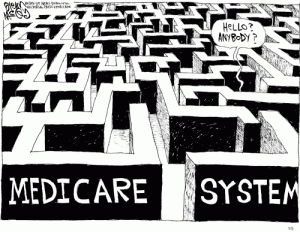By Jack Cumming
Do you know what the phrase “real-world evidence” means? Increasingly, we live in a world in which jargon masquerades as erudition at the expense of clarity. In this case, I can define every word, but without speaking FDA-talk, I can have no concept of what the phrase means. Apparently, “real-world evidence,” affectionately referred to as RWE, is used by the Federal Drug Administration “… to help support the approval of a new indication for a drug already approved.”
Clarity or Obfuscation?
This tilt away from clarity and toward jargon became manifest recently with a webinar titled “2024 State of Real-World Evidence Policy.” As I listened to the speakers talk among themselves, it became clear that these were well-intentioned academic and government executives who wanted to improve health care by marrying artificial intelligence analyses with massive data collection to help guide improved health outcomes.
We’ll get to the official verbiage later, but we start with layperson language to help people concerned with senior living and age-related conditions and remedies wend their way through the jargon thicket. For the most part the speakers were highly specialized, mathematically astute, strongly credentialed social scientists.
Social Science Approach
Social scientists are trained to take data and run it through complex mathematical models, to predict the efficacy of this or that. Example: If a test of students shows that more prefer sugar to salt, then we can predict that cookies will get more approval than anchovies. In the larger context of the amelioration of human distress, it would be useful to know what medico-health-care approaches are most effective and under what conditions. That’s straightforward enough.
Artificial intelligence is reputed to be able to take massive amounts of data and process it with constructive algorithms to come up with unique insights that can be better than simple human judgment. Of course, as with any mechanistic process, the “insights” can also be flawed. Pondering the technical talk among the “experts” revealed that they were trying to achieve the former without the drawback of the latter.
Data Issues
The experts on this panel, and medical analysis in general at this juncture, seemed more concerned with data quality than with the veracity of the algorithms used to crunch that data. Data flaws are extensive. Data from electronic health records suffer from frequent miscodings (flawed computer entries), which a panelist attributed to coding being a low priority for clinicians.
Of course, it may also be that the system structure is complex and does not provide much support for the clinician’s effort to foster quality outcomes. Coding might improve if the system were seamlessly connected to the clinicians’ purpose.
Another intriguing data quality challenge for the technical panelists is what one referred to as missing data. For instance, a patient coming into a physician’s office may first have a conversation of medical substance with the receptionist. That interaction is not now generally captured, though it is possible with artificial intelligence for that conversation to be monitored and combed for medically relevant information.
Many other data quality challenges come to mind when thinking about the American system, not the least of which is the lack of a single central electronic health record, perhaps tied to the Social Security precradle-to-postgrave system. At least one panelist pointed to that kind of proprietary data fragmentation as a major challenge.
Examples abound. Data systems are often constructed for different purposes. Among those purposes are billing, claims, and collection; support for responsive treatments or wellness; medical documentation: utilization management; research efficacy; geographic health delivery equity; socioeconomic equity; and many other business or political purposes.
Health Care in the U.S.
We know that the United States lags other nations badly in the goal of delivering quality health maintenance at a proportionate cost. Moreover, we lack universal access, except that anyone can go to a hospital emergency department. The shortcomings of our health care system are challenges that should be central to any discussion of health care, whether for senior living or for the general population, but it seldom is.
Senior Living Opportunity
The Program of All-Inclusive Care for the Elderly (PACE), although statutorily limited, shows that absent legal restraints, the senior living industry could be, and may become, a force for reform to bring American medicine in line with that in other economically advanced nations.
That’s an opportunity that begs for leadership to put nation before special interests and deliberation before lobbying. Our American spirit is at its best when we are resilient in applying ingenuity to fashion unique solutions to thorny challenges.
As promised, here’s the official verbiage:
FDA has a long history of using what we currently call real-world data (RWD) and real-world evidence (RWE) to monitor and evaluate the postmarket safety of approved drugs. RWE has also been used historically to support effectiveness, but on a more limited basis. Advances in the availability and analysis of RWD have increased the potential for generating robust RWE to support FDA regulatory decisions.








